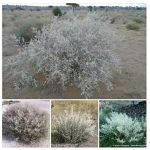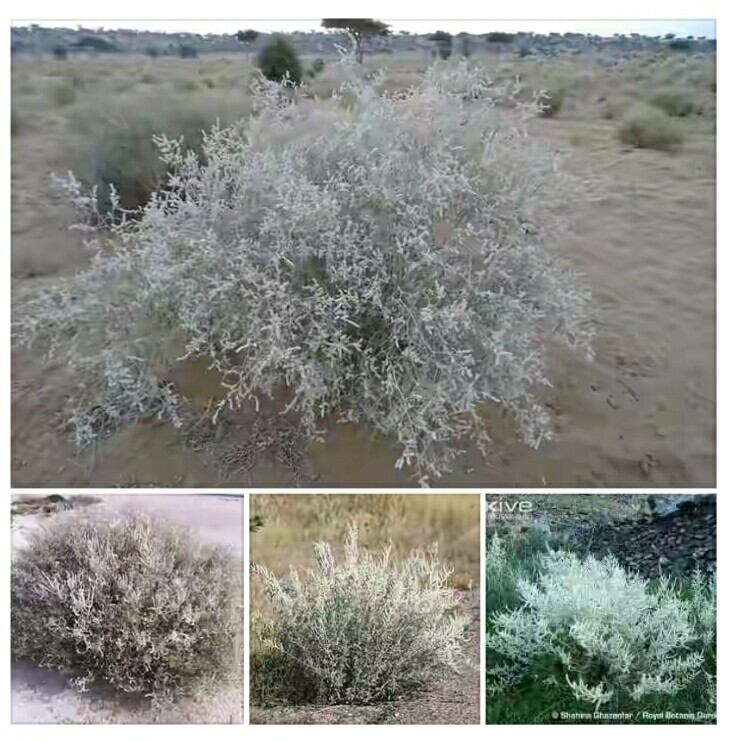Aerva javanica (Burm.f.) Juss. ex Schult. (Botanical name) or Kapok bush, Pillow-weed, Desert cotton (English) or Alhaji (from its appearance in allusion to the white habit of Mecca pilgrims), Furfura ta gyatumi, Furfura ta jatumi (Hausa)): A perennial semi-shrubby plant useful for veterinary application in the treatment of many animal disease and for grassland regeneration
DESCRIPTION AND OCCURRENCE: The Kapok bush is a perennial semi-shrubby plant growing in tropical and subtropical dry areas. It is both erect and spreading, grows up to a height of 1.5 m high, and is covered with densely matted hairs on stems and leaves. Aerva javanica is much-branched, with vigorous round stems that are woody at the base, and a dark stout taproot. It has numerous leaves, ovate to lanceolate, 10-20 x 40-75 mm, alternate and white to grey. The flowers are small and whitish and arranged in dense, woolly terminal panicles. Aerva javanica is used for grazing in dry rangelands and has been planted for forage in Australia, where it is regarded as a useful fodder. IN EARLIER TIMES, THE DENSELY WOOLLY PARTS OF THE INFLORESCENCE WERE USED BY BEDOUINS FOR STUFFING SADDLE PADS AND CUSHIONS, HENCE THE NAME “KAPOK BUSH”.
Aerva javanica is widespread in semi-arid and arid regions of the tropics and subtropics. It is found throughout much of mainland Africa, on the Cape Verde islands and in Madagascar, in the Arabian Peninsula and areas further eastwards in southern Asia and the Indian sub-continent. According to information by Queensland Government (2011), it was introduced in the 1880s in Australia to help regenerate rangeland areas.
USES/HEALTH BENEFITS OF AERVA JAVANICA (KAPOK)
Aerva javanica has many uses in human and animal ethnomedicine. In Pakistan, it is used as a purgative, antidiarrheal and anthelmintic medicine in cattle. In India, boiled seeds are fed to animals suffering from foot and mouth disease.
In Ethiopia, roots are used to treat ophthalmic infection in goats. Aerva javanica contains secondary metabolites (flavonoids, alkaloids, tannins, sterols, etc.) that have been investigated in veterinary medicine. In India, a paste made of green leaves, used for healing wounds and inflammation, was found to have antibacterial activity. Aerva javanica has been used for grassland regeneration in severely degraded areas due to excessive grazing.
In North-West Australia, a reseeding programme using kapok bush as a colonising species began in 1960. It aimed to assist development of a favourable seedbed for native and sown species: buffel grass (Cenchrus ciliaris) and birdwood grass (Cenchrus setiger) in ploughed contour bands. It was largely successful, with significant re-establishment of native grass species a few decades later. Information on the utilization of Aerva javanica by ruminants is scarce.
In Africa, it was shown to provide grazing for livestock in Mauritania, the central Sahara region and Senegal, for sheep in Somalia, and for domestic livestock and game in Kenya. In Southern Egypt, the Bedouins consider that it has a low grazing value but that the flowers are valuable for lactating ewes. The palatability of Aerva javanica depends on the livestock species.
In the Thal and Cholistan deserts of Punjab, Pakistan, it was observed that it was only grazed by sheep and goats, whereas camels, cattle and buffaloes did not eat it. Early reports from Africa showed that it was palatable to goats and sheep, while cattle would only make use of it as dry season forage. It was said to be unpalatable to cattle (Chad) and camels (Hoggar, Somalia). In the latter country, camels found it distasteful and took it only in default of better browsing. In Kenya, Aerva javanica was grazed by eland.
In Southern Egypt, Aerva javanica was found to have a moderate protein content (13% DM) in the winter season, which decreases to 4% in the dry season.

FOR FURTHER READING SEE:
1. Giday, M.; Teklehaymanot, T., 2013. Ethnobotanical study of plants used in management of livestock health problems by Afar people of Ada’ar District, Afar Regional State, Ethiopia. J. Ethnobiol. Ethnomed., 9 (8).
2. Khan, F. M., 2009. Ethno-veterinary medicinal usage of flora of greater Cholistan desert, Pakistan. Pak. J. Vet., 29 (2):75-80.
3. Mistry, N. ; Silori, C. S. ; Gupta, L. ; Dixit, A. M., 2003. Indigenous knowledge on animal healthcare practices in district Kachchh, Gujarat. Indian J. Trad. Knowl., 2 (3): 240-254.
4. Queensland Government, 2011. Weeds of Australia. The University of Queensland. Special edition of Environmental Weeds of Australia for Biosecurity Queensland
These are the thoughts of:
Sa’eed Halilu Bawa
Senior Lecturer (Associate Professor) at University of the West Indies, St. Augustine Campus, Trinidad.
Studied Food and Nutrition Sciences, Dietetics at Kaduna Polytechnic, Nigeria; Warsaw University of Life Sciences, Poland.
























